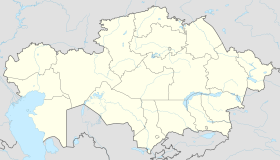Kustanai
|
Kostanay Қостанай |
|||
|---|---|---|---|
 |
|||
|
|||
| Location in Kazakhstan | |||
| Coordinates: 53°12′N 63°37′E / 53.20°N 63.62°ECoordinates: 53°12′N 63°37′E / 53.20°N 63.62°E | |||
| Country | Kazakhstan | ||
| Region | Kostanay Region | ||
| Founded | 1879 | ||
| Incorporated (city) | 1893 | ||
| Government | |||
| • Akim (mayor) | Bazyl Zhakupov | ||
| Area | |||
| • Total | 240 km2 (90 sq mi) | ||
| Highest elevation | 185 m (607 ft) | ||
| Lowest elevation | 125 m (410 ft) | ||
| Population (2014) | |||
| • Total | 217,135 | ||
| • Density | 900/km2 (2,300/sq mi) | ||
| Time zone | Asia/Almaty (UTC+6) | ||
| Postal code | 110000 | ||
| Area code(s) | +7 7142 | ||
| Vehicle registration | P | ||
| Website | www |
||
Kostanay (Kazakh: Қостанай, Qostanay, قوستاناي) is a city located on the Tobol River in northern Kazakhstan. It was known as Nikolayevsk (Russian: Николаевск) until 1895 and then as Kustanay (Russian: Кустанай) until 1997. Kostanay is the administrative center of the Kostanay Region.
Kostanay was founded by Russian settlers in 1879 and named Nikolaevsk, in honor of Tsar Nicholas II. In 1888, the town had more than 3,000 inhabitants involved in the building of a mill and a brewery, which are still operational. In 1893, Kostanay was granted city status. The Red Army took control in 1918 and changed the city's name to Kostanay. The Kostanay Region was established in 1936 with its administrative center in Kostanay. In 2009, the city population was 214,916 (2009 Census results).
In Kostanay, there are five institutions of higher education. There are also 22 high schools which educate over 12,200 students. The state network of culture lists 381 libraries, 201 club establishments, 8 museums, and 2 theatres. Athletic facilities include 2 sports arenas, 26 stadiums, 10 sports complexes and 567 sports halls.
Kostanay has a rich historical-cultural heritage. The regional center includes a Sunni mosque, the Regional Administration Building, Kostanay State University, the Kostanay Regional Memorial Museum of Altynsarin, the Kazakh Drama Theatre, Central Square and a railway station. Historical monuments include the Ybyrai Altynsarin monument, the Akhmet Baitursynov monument, a memorial dedicated to victims of the Second World War, the "Execution wall" (where Alexander Kolchak's army officers were executed by Red Army soldiers), and the Alexander Pushkin monument.
...
Wikipedia



